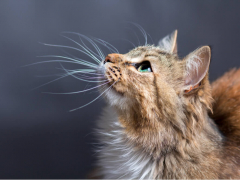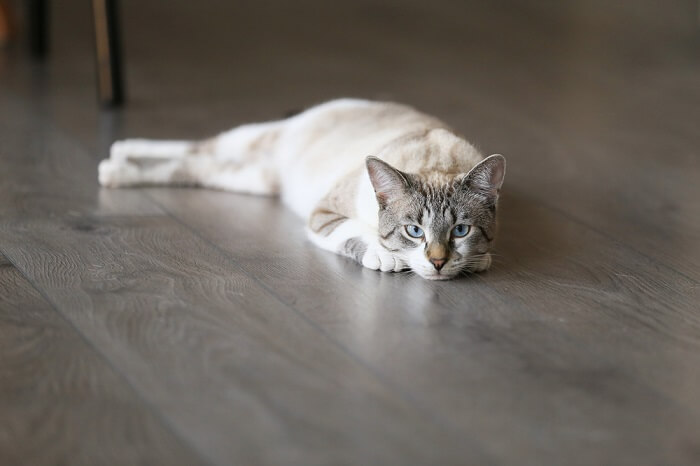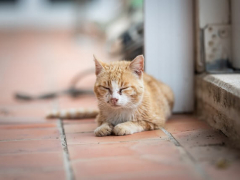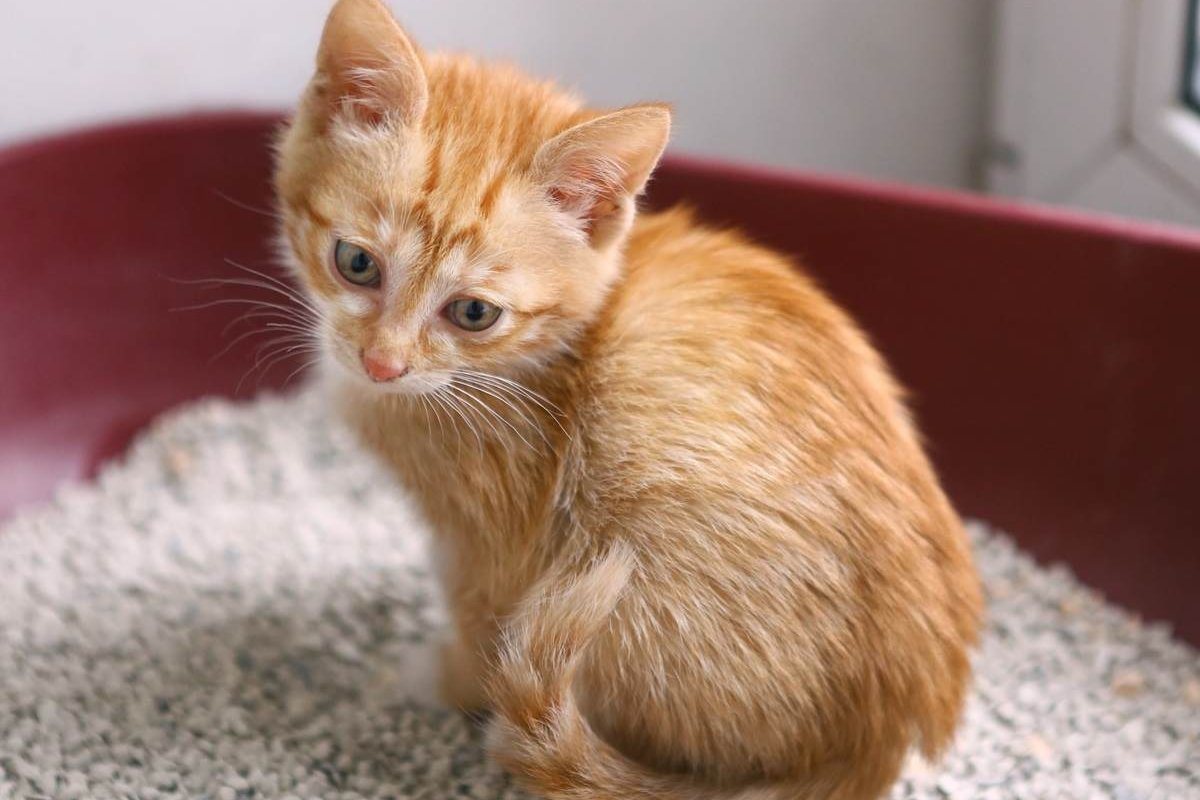
Coccidia is an intestinal parasite causing diarrhea that more often affects young kittens. Lapina / Shutterstock.com
Coccidia in cats refers to a broad category for a group of protozoal internal parasites that can cause diarrhea, especially in kittens and cats housed in high volume environments like shelters, catteries, and colonies.
In cats, coccidia usually refers specifically to Cystoisospora (Isospora) species. Cystoisospora is the preferred name, changed from Isospora in 2005[1], but you can consider the two terms interchangeable. Coccidian parasites are single-celled, protozoal organisms. Unlike other internal parasites like roundworms and hookworms, which are actual worms, protozoal organisms are different. Protozoan parasites are more often round or oval-shaped organisms and can only be seen under a microscope.
In this article, you’ll learn more about what coccidia in cats is, how to recognize signs of illness, how it’s treated, and some frequently asked questions.
Causes of Coccidia in Cats
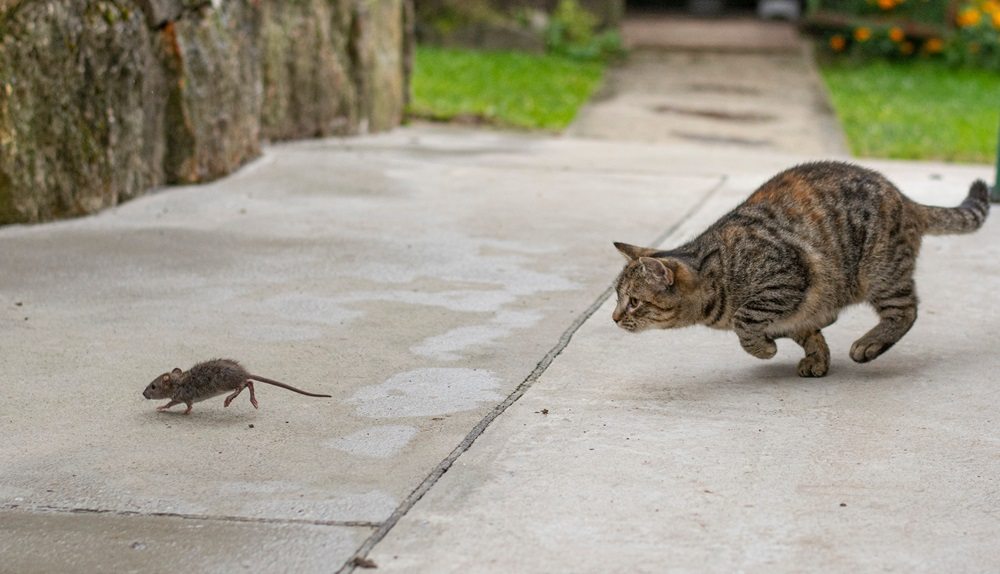
Although less common than fecal-oral transmission, hunting mice and other small rodents can lead to coccidia infection in cats. Stefan_Sutka / Shutterstock.com
Cats can be affected by two types of coccidia: Cystoisospora felis and Cystoisospora rivolta. The two types cause the same signs of illness and knowing which species is causing an infection is typically not important from a disease diagnosis and treatment standpoint.
While coccidia in cats can affect cats of any age, it more often affects kittens less than 3-6 months old. Sick, injured, or immunocompromised cats (including pregnant queens) are also more likely to show signs of illness.
In a study[2] looking at parasitic infections in nearly 3,000 cats from 2007 to 2018, Cystoisospora was the most common, affecting about 10% of cats. Coccidia infections in cats can vary by region, ranging anywhere from only 3% of cats up to almost 40% of cats tested.
There are two main ways that cats can develop a coccidia infection.
Fecal-Oral Transmission
The most common route to infection is feces ingestion. Cystoisospora oocysts (pronounced “oh-oh-cysts”)—the parasite eggs—are present in infected animals’ stools. If another cat ingests the contaminated stool and the oocysts, Cystoisospora will then develop an infection in the new cat.
Oocysts must undergo a process called sporulation to become infective. In the right conditions, an oocyst passed in stool can sporulate and become infective in just under 24 hours. Temperatures between about 70 and 90 degrees Fahrenheit are ideal for this.
The fecal-oral route of cat coccidiosis might occur more easily than you think. It doesn’t mean a cat is seeking out poop to eat. For cats who share litter boxes, a small amount of stool residue can end up on a cat’s foot. Cats are fastidious groomers and coccidia oocysts can be ingested during self grooming or co-grooming in a multi-cat environment.
Kittens are especially susceptible to infection. Their mothers can often be shedding coccidia in their stool (though they may not show symptoms) providing a source of environmental contamination for their kittens. Kittens can step in each other’s stool and track it around, easily leading to spread.
Hunting/Predation
The second transmission route occurs when a cat eats another small animal that has been indirectly infected with a coccidia parasite.
Cats are the only true hosts of C. felis and C. rivolta. But there can be indirect hosts, also called paratenic hosts, that can become a source of infection for cats. If a small mammal like a mouse ingests coccidia oocysts, it cannot cause disease in them because they are not the right host, but it will form a cystic stage called a cystozoite.
If a cat then hunts and eats a mouse with cystozoites, the encysted form can become active in the cat, leading to infection. Besides small rodents like mice, it may be possible for birds and even insects[3] to be sources of infection for cats through this route.
Symptoms of Coccidia in Cats
Many cats infected with coccidia may have no symptoms of illness at all. Healthy adult cats can shed the parasite in their stools but may have no signs of diarrhea. Cats most often developing illness from coccidia are young kittens (usually less than 3-6 months old), cats with immunocompromise (pregnant or nursing queens, FIV or FeLV positive cats), cats under population stress (colony cats, shelters), or cats with other diseases affecting their health.
In cats that develop disease, the general time period from infection to onset of symptoms is about 4-14 days. In these cats, common signs of illness can include:
- Profuse, watery diarrhea
- Diarrhea with mucus
Less common signs of illness that occur with more severe infections include:
- Diarrhea with blood
- Poor appetite (anorexia)
- Dehydration
- Lethargy
- Vomiting
These less common but more severe signs are more likely to occur in young kittens. It is possible for kittens to die from a severe coccidia infection due to dehydration and loss of nutrients through diarrhea.
Diagnosis of Coccidia in Cats
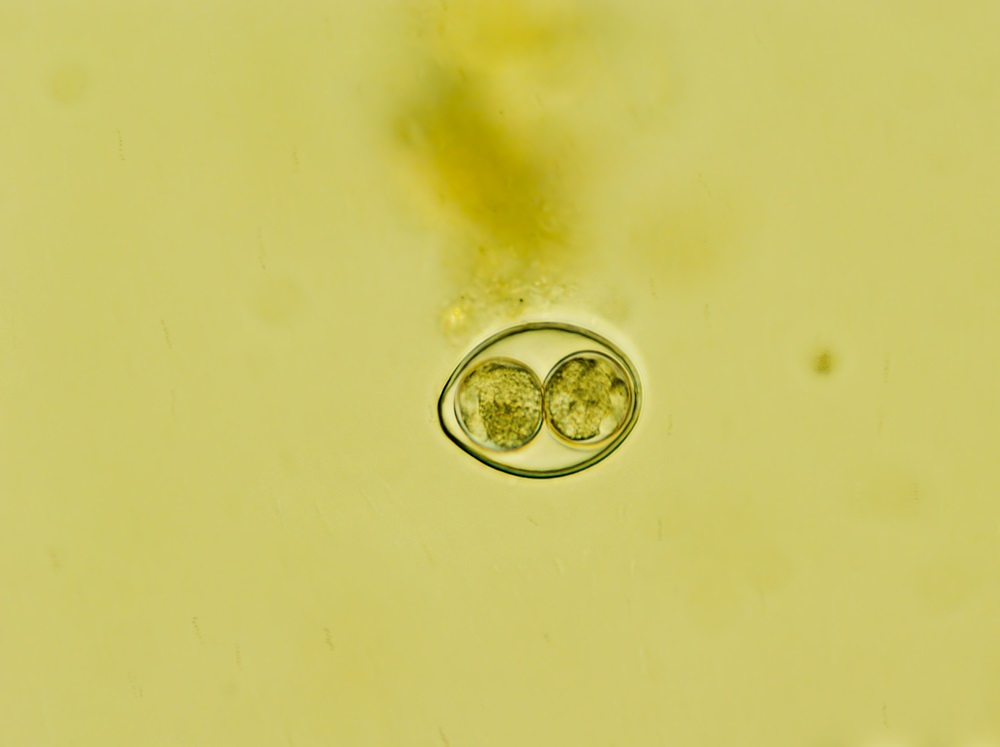
The view of a Cystoisospora oocyst under a microscope. Todorean-Gabriel / Shutterstock.com
Coccidia in cats may be suspected in any cat, especially a kitten, having watery diarrhea. But although coccidiosis can be common in cats, there can be many other causes of diarrhea, and coccidia involvement should never just be assumed.
Coccidia is easily diagnosed with a fecal examination via your veterinarian. Most often, samples are sent out to a laboratory. There are many different types of coccidia and not all cause disease in cats, so having a verified result is important for diagnosis.
Cystoisospora may be detected by looking for the oocysts in a stool sample under a microscope. The number of oocysts found can help to estimate the severity of infection.
In the last couple of years, fecal PCR testing (looking for parasite DNA) has become more common. This type of testing can also be very specific for the type of coccidia and estimate the severity of the infection.
Treatments for Coccidia in Cats
There are two types of medication used to treat coccidia infections in cats.
Sulfadimethoxine (Albon)
Albon is an antimicrobial that can halt the reproduction of Cystoisospora, allowing the host’s immune system and the parasite’s life expectancy to do the rest.
Albon is FDA approved for use in cats for enteric infections, however, treatment specifically for coccidia infections is considered an off-label use. The FDA-approved dose (which is often used for coccidia infections) is 55mg/kg once on the first day, followed by 27.5mg/kg every 24 hours for the remainder of the treatment period.
The treatment period can vary widely. On average, Albon may be continued for most cats for 1-2 weeks (I aim for 10 days myself for most courses). However, because it does not kill coccidia but only halts their reproduction, treating some cats with heavier infections may take longer, even up to 3 weeks. Treatment success may be guided based on recheck fecal samples and the improvement of symptoms.
The 50mg/ml solution is the most common form prescribed for small cats and kittens for ease of dosing. The solution is yellow in appearance and can get confused with pyrantel (Strongid) if not labeled properly. The tablets may also be used in larger adult cats.
Ponazuril (Marquis)
Ponazuril is an antiprotozoal medication that was first developed for horses to treat Sarcocystis neurona infections. Because Sarcocystis is a similar organism to Cystoisospora, ponazuril started being used many years ago to try treating coccidia infections in small animals.
Ponazuril is a coccidiocidal, meaning it actually kills the parasites. Recent studies[4] have supported the use of ponazuril to treat Cystoisospora in cats, showing that infections may be practically resolved within only a couple of days.
However, ponazuril used to treat cats, especially small kittens, does present some obstacles. Ponazuril is marketed as the brand ‘Marquis’, which is only labeled for use in horses. Marquis comes as a paste in a large syringe intended to treat up to 1200 lb of horse and usually costs over $300.
Dosing something much smaller can be challenging to do accurately and the cost makes it impractical for individually-owned cats. 1 gram of Marquis contains 150mg of ponazuril. An average-sized 10 lb cat might get 1-2 grams, but in really small kittens, this might be ½ gram or less. Dosing such a small amount out of the Marquis syringe can easily lead to overdoses, which has not been studied well in cats.
Because of this, dosing for small cats and kittens is best done through a compounding pharmacy to ensure the accuracy and safety of the dosage. It may be common for shelters to share one tube of Marquis among multiple cats, which saves on cost and is more practical as it requires less time to treat, but they do so at an accepted degree of risk. Because this medication is used off-label, your veterinarian should help you with dosing and compounding if you want to consider it as a treatment option for your own cat.
Supportive Treatments
In addition to treating the organism itself with medication, other supportive care therapies may be needed for cats or young kittens that develop significant disease. Some of these other therapies may include:
- Appetite stimulants
- Fluids, either under the skin or intravenously in serious cases of dehydration
- High-calorie recovery diets
- Nutritional supplements like Nutri-Cal
- Feeding tubes or parenteral nutrition (in very serious cases)
How to Care for Your Cat With Coccidia
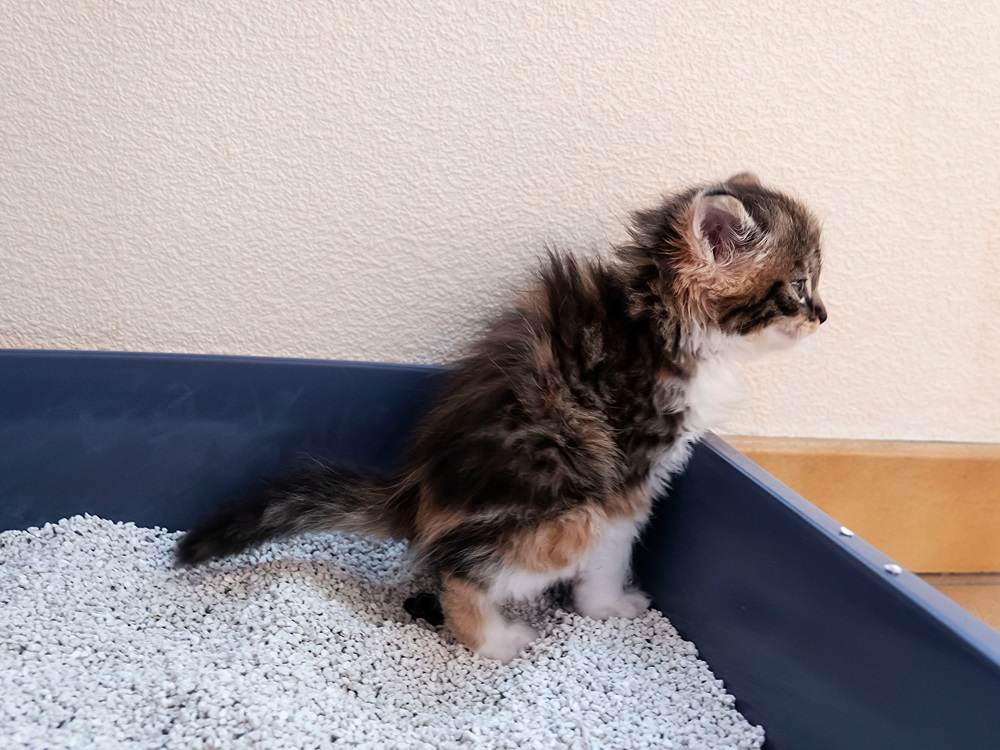
Keeping litter boxes regularly scooped and cleaned is a key part of caring for a cat with coccidia. irinacapel / Shutterstock.com
Most cats with coccidia infection show no signs of illness, but if your cat or kitten is having diarrhea, here are some tips to help out at home.
- Hygiene: Keep all food/water bowls, housing, and litter boxes cleaned and sanitized daily to prevent further spread. Using dilute chlorine bleach[5] at 1 cup of bleach to 1 gallon of water will kill the oocysts. (Just remember that bleach can damage many surfaces).
- Litter trays: Scoop litter boxes thoroughly twice a day to remove stool transmission risk (remember the oocysts become infective in about 16 hours).
- Nutrition: Ensure your cat is keeping up with food and water consumption. Dehydration can occur very quickly, especially in kittens. Any young kitten who stops nursing should receive immediate care.
Prevention of Coccidia in Cats
There is no medication that can prevent coccidia infection in cats, and no monthly prevention product is available. This does mean that cats can get reinfected. Here are some tips for reducing risk.
- Hygiene: In high-volume environments (shelters, catteries, colonies), clean and sterilize any common-use items at least daily.
- Testing: Have a stool sample checked at least annually for your cat. Even if there are no signs of disease, cats may shed coccidia in their stool, presenting an environmental contamination risk. Stool/fecal samples should always be checked more frequently for pregnant queens and young kittens. Always check a sample prior to introducing a new cat or kitten to the home (for both the new cat and any cats currently in the home)
- Quarantine: Keep any new kittens separated from other cats in the home for at least a couple of days to observe for signs of illness and have a stool sample checked.
- Optimize health: Ensuring a general state of health and reducing stress (including overcrowding) can be the best way to prevent coccidia from causing severe illness.
Frequently Asked Questions
Is Eimeria the same as coccidia?
Eimeria is a type of coccidia parasite. However, Eimeria [6] is a type that infects wildlife (including rabbits and squirrels) and farm animals (like sheep and goats). Sometimes, a cat’s stool sample may show presence of Eimeria, but this is only due to either a cat ingesting the stool of one of those animals, or through predation. Eimeria cannot cause disease or illness in cats.
Can humans catch coccidia in cats?
Coccidia like Cystoisospora (and Eimeria) parasites are extremely host specific. While humans can contract a human specific coccidia called Cystoisospora belli [7] , people cannot get Cystoisospora infections from their cats (or dogs). Cats and dogs also cannot contract Cystoisospora from humans. Toxoplasma and Cryptosporidium are coccidians that can cause zoonotic disease (transmissible from human to animal and vice versa) but when we talk about coccidia in cats, we are typically referring only to Cystoisospora.
How contagious is coccidia to other cats?
Coccidia in cats can be very easily transmitted between cats who are sharing close living quarters, litter boxes, etc. While a healthy adult cat may not develop signs of illness from Cystoisospora infection, they can be a source of infection for a young kitten or an older or immunocompromised cat who can develop more serious illness.
-
Hanau, S., & Contini, C. (2022). Cyclospora and cystoisospora. In Elsevier eBooks (pp. 463–474).
-
Nagamori, Y., Payton, M. E., Looper, E., Apple, H., & Johnson, E. M. (2020). Retrospective survey of parasitism identified in feces of client-owned cats in North America from 2007 through 2018. Veterinary Parasitology, 277, 109008.
-
Gastrointestinal parasites of cats. (n.d.). Cornell University College of Veterinary Medicine.
-
Burlison, C., Cox, S., Smith, J., Stokes, J., Whittemore, J. C., & DeBolt, B. (2022). Pharmacokinetics of orally administered single‐dose ponazuril in cats. Journal of Veterinary Pharmacology and Therapeutics, 45(3), 229–234.
-
Coccidiosis in cats | VCA Animal Hospital | VCA Animal Hospitals. (n.d.). Vca.
-
Bailey, C. A. (2020). Precision poultry nutrition and feed formulation. In Elsevier eBooks (pp. 367–378).
-
About cystoisosporiasis. (2024, May 2). Cystoisosporiasis.
-
Dacvm, A. M. Z. D. P. (2020, April 28). Giardiasis and coccidiosis (Proceedings). DVM 360.
-
Plumb’s Veterinary Drug Handbook, 10th Edition. (n.d.). Wiley.com.
-
Diagnosis and treatment of cryptosporidium and isospora in cats - WSAVA2011 - VIN. (n.d.).
